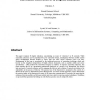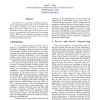SIGPLAN
2008
14 years 2 months ago
2008
While the programming languages course played a key role in Curricula '68, '78, and '91, Curriculum 2001 replaced most of the content in programming languages with ...
SIGPLAN
2008
14 years 2 months ago
2008
Three key forces are shaping the modern Computer Science (CS) curriculum: (1) new topics/courses are squeezing out existing ones; (2) a focus on "big picture" and interd...
SIGCSE
2008
ACM
14 years 2 months ago
2008
ACM
ion." These images do not foster collaboration with other fields and do not excite the curiosity of young people. In this session, Astrachan and Denning will discuss what they...
EJIS
2007
14 years 2 months ago
2007
This paper examines IS higher education, concentrating on issues of ‘coherence’ in IS curricula. While curriculum coherence can be jeopardized by poor curriculum design, misal...
CORR
2010
Springer
14 years 3 months ago
2010
Springer
Serious games have recently emerged as an avenue for curriculum delivery. Serious games incorporate motivation and entertainment while providing pointed curriculum for the user. Th...
ITICSE
2010
ACM
14 years 3 months ago
2010
ACM
We present the curriculum, deployment, and initial evaluation of a course, BioCS1, designed to serve as CS1 and Biology1 for majors of either (or both) disciplines. Cotaught by pr...
IADIS
2004
14 years 4 months ago
2004
This paper describes the development and evaluation of a curriculum designed to help teachers learn about and integrate digital library functionalities and learning objects into t...
SERVICES
2008
14 years 4 months ago
2008
Described here is a proposed curriculum design for service engineering based on the six years of experience of a master's program at the School of Software and Microelectroni...
ECTEL
2007
Springer
14 years 6 months ago
2007
Springer
When a curriculum is proposed, it is important to verify at least three aspects: that the curriculum allows the achievement of the user's learning goals, that the curriculum i...
HINC
2003
Springer
14 years 8 months ago
2003
Springer
With the acquisition of the first computer in 1964 programming was introduced into the engineering curriculum at the University of Iceland. Subsequently applied mathematics curricu...


